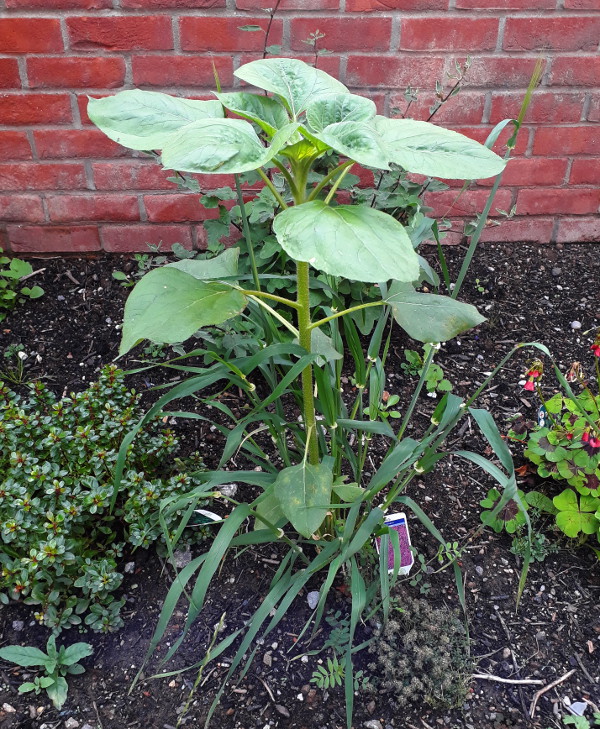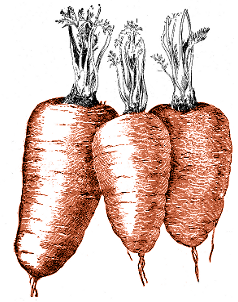Posts tagged ‘sunflower’
Posted in Garden Diary on Thursday, October 21st 2021 (10.13 PM).
This might be the last post on the garden blog for a while; it looks as if it will be going onto a hiatus, for various reasons we don’t need to go into, for an indefinite period. Nevertheless, in the last post I promised to give an update on whether or not the strange chimeric bird food plant—a sunflower surrounded by wheat—would flower. And, indeed, it did. To the delight, as you can see, of bumblebees.

I took this picture about six weeks ago, and it’s been sitting in my to-do pile since. You can see the heads of wheat at the bottom, green still; by now everything has ripened, the wheat has gone yellow and the sunflower has turned into seed for all the local birds. Six weeks ago, as you can see, its yellow was still rich. I’m intrigued by the shape, those tendril-like petals extending like tentacles all the way round. Naturally, I have no idea of finding out what variety it is to try to reproduce it.
sunflower, helianthus, bee, bumblebee
Posted in Garden Diary on Saturday, August 14th 2021 (9.22 PM).
If there were any regular readers of this blog, they would have noticed that since the last post, when the garden was being radically relandscaped, there haven’t been any further updates. Well, the landscaping has finished since then, the garden now has a lawn, an apple tree and a variety of beds which are slowly being populated with plants. So far, of course, the plants all appear to be tiny little things somewhat dwarfed by the amount of empty bare earth between them, but that will slowly change.
This post, though, is something of an aside, before I get around to the Proper Post with a map of the garden and summaries of some of the plants that have been scattered about. Because between a couple of plants which had been properly planted, a strange weed grew up. It started growing and grew up fast; and it seemed to have a strange mixture of leaves, some of them long and thin like a grass and some broad and heart-shaped. In other words almost as if it was a chimera of two completely different types of plant, half-monocotelydon and half-dicotelydon. Outside of science fiction, that’s completely and utterly impossible.
Well, I looked at it more closely today, and I’ve realised what it is. Take a look yourself and see if you can spot it.

So what sort of plant is it, that I’ve realised I have? It’s a bird food plant, of course!
No, really, look. In the middle, that’s a typical sunflower stem with its flower forming at the centre. Round the outside, some sort of cereal plant, possibly barley. Why on earth would you have a sunflower and a few stems of barley all germinating in exactly the same spot? Because a small lump of bird seed cake was dropped there and has started to grow, of course.
Whether it was accidentally dropped by a passing jackdaw or wood pigeon, or whether it was in the topsoil when it arrived and has germinated now it has light, I don’t know and will never know. The topsoil certainly does have a good number of weed seeds in it, a significant proportion of them nettles, so it possibly was in the soil before it was spread out. The sunflower has probably started a little late in the season for best results, but it will be interesting to see just how high and fast it manages to grow before autumn. If it flowers, I’ll make sure I take a picture.
weeds, weed, sunflower, helianthus
Posted in Decorative, Experimentation, Garden Diary, Practicalities, The Old Garden In Bristol on Sunday, April 17th 2016 (9.18 PM).
This afternoon, I finished weeding the rosebay willowherb, until more shoots spring up at least. Weeded every shoot I could see, dug up every rhizome I could find, levelled out the soil and spread a layer of compost across the top.
The sowing plan for the bed starts with: peas at the back, against the trellis. Now, I’ve had issues with pea support in the past, and I suspected that the laths of the trellis are a bit big for a pea plant to wrap a tendril around, so the trellis has been covered in green plastic pea netting. It’s not the prettiest solution but it’s not too obtrusive; and I’m sure the vines of the back neighbour’s honeysuckle will love clinging onto it too.
In the front of the bed, we have scattered various seeds, mostly flowers, in the hope that the will grow up in front of the pea plants without eclipsing them entirely. We’ve scattered handfuls of:
- Cornflower, Centaurea cyanoides “Blue Diadem”
- Night scented stocks, Matthiola bicornis
- Corn marigold, Chrysanthemum segetum
- Poppy, Papaver rhoeas “Flanders”
- Swiss chard, Beta vulgaris vulgaris Cicla-Group “Five Colour Silverbeet”, because Gretchen has spotted it elsewhere and liked the different colours of the leaves.
- Tree spinach, Chenopodium giganticum “Magenta Spreen”, scattered from a packet I bought a couple of years ago and intended to sow but never did. The aim of the tree spinach is much as it was when I bought the packet: it has been sowed in the left-hand end of the bed, a dark and fairly damp corner where not much grows apart from dandelions. Tree spinach might prefer sun, but will hopefully cope with the shade there; and there won’t be any peas at that end that it might crowd out.
There are also nasturtiums, Tropaeolum majus “Empress of India”, apparently “a classic Victorian variety” according to the Internet, sowed in a couple of spots, their seeds like tiny miniature brains. The key to all of this, of course, is the idea that the peas are going to clamber up high enough and quick enough that none of the stuff around them will cause any problems. The other key, which you might have realised, is that nearly all of the ornamental (or semi-ornamental) stuff is self-seeding. Hopefully, once everything is set up, everything will keep on going year after year, or at least until we move house.
This is all very experimental and no doubt a Proper Gardener would tell us we were trying to cram far too many plants into a tiny space. However, we will wait and see. I won’t be surprised if not everything develops, or at least, doesn’t grow exactly how I originally envisaged things. It might need a bit of tweaking next year, or it might all come up again, irregular but satisfactory.
I’ve given up on the calendula seeds mentioned previously, and bought a new packet. Into pots, we sowed:
- More calendula, obviously.
- And more Tropaeolum majus.
- Mixed rocket leaves
- A different dwarf sunflower, Helianthus annuus “Choco Sun”, allegedly one of the smallest sunflower varieties available. Short enough for a toddler to sniff, I hope.
And with a general tidy-up, the garden is looking reasonable again. The back bed may be bare soil now, but hopefully within a month or two it will be full of greenery, and mostly the greenery we intended, too. In the tidy-up a lot of the wooden containers were thrown away, their wood rotted too far to save them, but that leaves us a good terracotta core. The plants we bought and potted up 2½ weeks ago are settling in nicely: the fennel looking lively, the thymes putting on new growth, and the marjoram already starting to fill up its pot. I’m rather pleased with how quickly things have been turned around. Even if things aren’t perfect yet, there’s not too much more tidying up left to do.
calendula, chard, corn marigold, cornflower, creeping thyme, fennel, french marjoram, green fennel, lemon thyme, marigold, marjoram, nasturtium, pea, poppy, rosebay willowherb, sowing, sowing plan, sunflower, swiss chard, thyme, tree spinach, weeding, Tropaeolum
Posted in Experimentation, Garden Diary, Practicalities, The Old Garden In Bristol on Thursday, April 14th 2016 (9.46 PM).
The first few pea shoots started to break the surface a couple of days ago, making it five days after sowing. Rather fast, I thought; only a few have come up so far, which makes me worry I’ve kept them too damp or something.
In the meantime I’ve been clearing out the back bed, into which the peas are going to be transplanted once large enough. A few years ago, I spent weeks clearing bindweed out of it, going through the soil archaeologically to excavate the tiniest pieces of bindweed rhizome. Now, after a couple of years of baby-rearing abandonment, it’s been colonised by rosebay willowherb. So I’m going through the soil almost archaeologically again, pulling out chunky pieces of rosebay willowherb rhizome this time. Hopefully I have got as much as possible: if I’ve missed any, once there are other plants in there the archaeological approach isn’t likely to work very well. I will have to resort to pulling up each shoot again and again until the rhizomes are exhausted.
There is still no signs of the calendula seeds we sowed twelve days ago germinating. To be honest I have no idea how long they normally take to germinate, but as I usually tend towards the impatient side, and I was always a bit skeptical that the packet would still contain viable seeds, I am suspecting that nothing is going to appear. Pushing on ahead, today we planted a pot of borage seeds (Borage officinalis) and another of poached eggs, which is hardly the nicest plant name I’ve ever come across, so I think I’ll just refer to it as Limnanthes douglasii from now on. Both pots will only really be large enough for one plant of each; a rather small plant in the borage’s case; but that will suffice. There may be just enough room for one borage plant in the back bed too, in front of the peas, but I doubt it with everything else I’d like to squeeze in there.
We did also buy a few plants from the greenhouse at St Werburghs City Farm, which sells plants as part of its horticulture training scheme for adults with special needs. A couple of chervil (Anthriscus cerefolium) and a dwarf variety of sunflower, which hopefully should grow to about the same height as the children. They were repotted this afternoon, despite a cold shower of rain, and with the children “helping” moving the compost about.
borage, calendula, chervil, germination, limnanthes douglasii, pea, rosebay willowherb, sowing, sunflower, weeding



